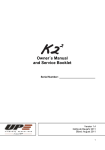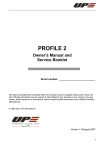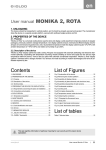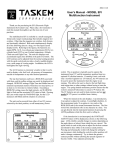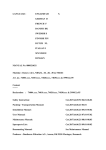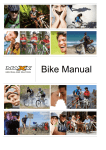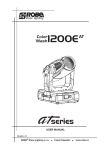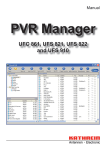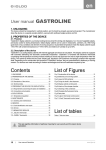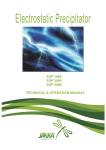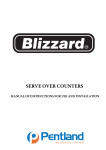Download E0110.74 Edition 8 - Hoffmann Propeller
Transcript
OPERATION AND MAINTENANCE MANUAL No. E 0110.74 for FIXED PITCH PROPELLER HO( ) Series HO4( ) Series HOFFMANN GmbH & Co. KG Küpferlingstraße 9 D-83022 Rosenheim Tel.: ++49/(0)8031/1878-0 Fax: ++49/(0)8031/1878-78 Owner's Manual No. E0110.74 61-10-01 8. Edition Feb. 2002 I Chapter 1 Designation.................................................................................................................. 1-1 2 Construction ................................................................................................................ 2-1 3 Installation Instructions .............................................................................................. 3-1 4 Inspection and Maintenance ...................................................................................... 4-1 5 Maintenance and Repair ............................................................................................. 5-1 6 Storage and Shipping ................................................................................................. 6-1 Owner's Manual No. E0110.74 61-10-01 8. Edition Feb. 2002 II Record of Revisions to this Manual Rev. No. Issue Date Date Inserted Owner's Manual No. E0110.74 61-10-01 Inserted by Ref. No. Issue Date Date Inserted Inserted by 8. Edition Feb. 2002 III List of Illustrations Fig. 2-1 Hoffmann blade tipping Type A Chapter 2 Page 2-1 Fig. 2-2 Hoffmann blade tipping Type B or C Chapter 2 Page 2-2 Fig. 4-1 Normal erosion, no matter of concern Chapter 4 Page 4-1 Fig. 4-2 Erosion tipping Type A Chapter 4 Page 4-2 Fig. 4-3 Erosion tipping Type B and C Chapter 4 Page 4-3 Fig. 4-4 Fine cracks in the paint or the tipping Chapter 4 Page 4-4 Fig. 4-5 Cracks in the paint or blade Chapter 4 Page 4-5 Fig. 4-6 Hair- cracks in the paint Chapter 4 Page 4-6 Fig. 4-7 Radial cracks Chapter 4 Page 4-7 Fig. 4-8 Tangential cracks Chapter 4 Page 4-8 Fig. 4-9 Cracks in paint caused by short lamellas Chapter 4 Page 4-9 Owner's Manual No. E0110.74 61-10-01 8. Edition Feb. 2002 Chapter 1 1 1-1 Designation Designation of 2-bladed propeller HO- 27 ( ) ( ) -( ) 183 ( ) 100 ( ) ( ) 1 2 3 4 5 6 7 8 1: Hoffmann GmbH & Co. KG 2: key number of hub connection (according. to manufacturers list) 3: additional modification to hub connection (figure or letter, according to manufacturer's listing 4: blank: hardwood propeller HM: 9 10 hardwood, fibre covering 5: number of blade design, contains construction and aerodynamic data (according to manufacturer's listing 6: propeller diameter in cm 7: blank: standard blade S: narrow blade 8: B: wide blade pitch H at the reference station. Reference station standard 0,75 R. Older models can differ in ref. station. 9: blank: right-hand tractor 10: D: right-hand pusher L: left-hand tractor LD: left-hand pusher denotes hub shape blank: cylindrical hub K: Owner's Manual No. E0110.74 61-10-01 conical hub 8. Edition Feb. 2002 Chapter 1 1-2 Designation of 4-bladed propeller HO 4 / 1 2 27 ( ) ( ) 3 -170 4 5 ( ) 128 ( ) 6 7 1: Hoffmann GmbH & Co. KG 2: number of blades 3: key number of hub connection (according to manufacturers list) 4: blank hardwood HM: hardwood, fibre reinforced epoxy covering 5: propeller diameter in cm 6: blank: standard blade S: Owner's Manual No. E0110.74 61-10-01 8 narrow blade 7: B: wide blade pitch H at reference station. Reference station standard 0,75 R. Older models can differ in ref. station. 8: Blank: right-hand tractor D: right-hand pusher L: left-hand tractor LD: left-hand pusher 8. Edition Feb. 2002 Chapter 2 2-1 2 Construction 2.1. Standard hardwood composite construction 2.1.1 Basic material for these propellers is ashwood, selected for this special application and conditioned according to our manufacturing specifications. Continuous testing guarantees high quality. The wood is glued together to a block with water resistant glue. During manufacturing continuous quality control is applied. Dense lamination prevents the wood from wrapping. This fact guarantees equal performance for propellers of the same type. 2.1.2 Leading edge protection The special Blade-Tipping was developed by Hoffmann Propeller. There is no need to use rivets to fasten the metal sheet onto the blade. Therefore penetration of moisture, which causes problems on wooden propellers is nearly impossible. The blade tipping can be replaced as often as required. Type A is a brass metal strip soft soldered to a bronze fabric and glued to the blade FRP cover (Figure 2-1). Figure 2-1 Hoffmann Blade tipping (Type A) Owner's Manual No. E0110.74 61-10-01 8. Edition Feb. 2002 Chapter 2 2-2 Blade tipping Type B is a special aluminium strip glued directly to the wooden core of the blade (Figure 2-2). Blade tipping Type C is a special PU- strip (Polyurethane) blade tipping and also glued directly to the wooden core. Due to the material the leading edge is not painted. (Figure 2-2) Figure 2-2 Hoffmann Blade tipping (Type B, or C) 2.1.3 Surface protection and finish Several layers of special polyurethane paint (PU- paint) are sprayed onto the wooden body, or the fibre reinforced epoxy covering if installed, and the erosion tipping (with the exception of the Type C erosion tipping), this assures a high resistance to atmospheric conditions. This polyurethane paint shows also high resistance against erosion and mechanical damage. Coloured paint is required to protect the wood against UV-rays. The standard thrust side is painted dull black to avoid reflection of sunlight. For safety reasons the tips are painted with a different colour to make the transparent propeller disc visible when the propeller is running. 2.1.4 Special design Some propellers have a plastic covering of fibre reinforced epoxy to improve surface protection and stability characteristics of the blade. 2.2 Light weight propeller The wooden core of this propeller is made of specially selected spruce. The wood is glued together in the same way as for the composite propeller. An additional advantage is less weight at comparable stability. This propeller differs from the composite propeller only by the decreased weight. The leading edge protection is conform with that of the composite propeller. Surface protection: All light weight propellers are covered with fibre reinforced epoxy to increase torsion stiffness and erosion protection. Then they are varnished like the composite propellers. Owner's Manual No. E0110.74 61-10-01 8. Edition Feb. 2002 Chapter 2 2.3. 2-3 Hoffmann 4-bladed propeller This propeller was designed to decrease propeller noise. 4-bladed propellers allow a smaller diameter than 2-bladed propellers at comparable performance and produce less noise. 2.3.1 Wooden core The ashwood lamellas are only half as thick as for a 2-bladed fixed pitch propeller. They are glued crosswise so that one long lamella is for two opposite blades. Between there are two short lamellas. This is done alternatively until the necessary height of the block is reached. 2.3.2 Leading edge protection The leading edge protection is conform with that of the 2 bladed composite propeller. 2.3.3 Surface protection The same methods are applied as for the light weight propeller. Owner's Manual No. E0110.74 61-10-01 8. Edition Feb. 2002 Chapter 3 3-1 3 Installation Instructions 3.1 Installation WARNING Before performing any work on the propeller follow the safety precautions given in the flight manual 3.1.1 Check propeller type and condition, clean propeller hub and let dry. 3.1.2 Clean the propeller and engine flange using solvent. Engine torque is mainly transferred by friction, therefore the surfaces have to be smooth and clean. Check bolts and thread for cracks and corrosion. 3.1.3 If there is a bolt hub, carefully check the connecting surface (cone, hub nut) parts and threads. WARNING Check the correct length of the bolts 3.1.4 Put the propeller on the engine flange or hub flange. Install front plate, bolts, washers and nuts, if applicable. Tighten bolts or nuts uniformly, torque crosswise (see 3.1.7). CAUTION If no spinner is used, the front plate must completely cover the centre bore of the propeller, to avoid water entering this part of the hub which destroys the propeller. CAUTION Propeller installation is subject to an immediate inspection by a licensed engineer 3.1.5 In case of bolt hubs 2 - 3 mounting bolts are necessary to centre the propeller. 3.1.6 If the bushings or the mounting bolts are stuck do not install the propeller (the hub may split open), it has to be removed and checked again. An excessive layer of lacquer in the bore can be scraped out. In case of discrepancies contact the manufacturer. 3.1.7 Use the recommended torque for tapered-, spline- or Hirth- hub installations, as specified by the engine manufacturer. Owner's Manual No. E0110.74 61-10-01 8. Edition Feb. 2002 Chapter 3 3-2 Torque values for dry threads: M6 9 - 10 Nm ( 80 - 88 inlbs) M 8 15 - 17 Nm (133 - 150 inlbs) M 10 23 - 25 Nm (203 - 221 inlbs) 3 / 8 - 24 UNF 23 - 25 Nm 203 - 221 inlbs 7 / 16 - 10 UNF 25 - 27 Nm 221 - 239 inlbs 1 / 2 - 20 UNF 33 - 35 Nm 292 - 310 inlbs Observe information on the sticker on the propeller. Use additional torque for the stop nuts, as required. Torque bolts crosswise. Make sure that the propeller fits to the flange or hub. No space is allowed between those two parts. WARNING Not following step 3.1.9 may result in the loss of the propeller WARNING Do not loosen the bolts while performing step 3.1.9 3.1.9 Check torque after the first flight, after the first 25 hours and after that as necessary, but at least each 50 hours by applying the required torque only. In hot and dry climate the wood may shrink, therefore closer re-torque intervals have to be established. NOTE: Some bolts, not specified herein, may require different torque. Please ask the company for the correct values. WARNING: Do not use any shimming material or paper to correct the track 3.1.10 Check blade track 10 cms (4 inches) from the blade tip on the trailing edge. Max. permissible are 3 mms (1/8"). If propeller is not within this limit, remove it, check mating surfaces or turn propeller 180°. If this procedure doesn't change the situation, send the propeller back to the factory. 3.1.11 Wire-lock the bolts in pairs or use the correct cotter pin to secure castellated nuts. Secure hub nut as specified in the engine manual. 3.1.12 It is strongly recommended to send the bolt-hubs to the manufacturer if the propeller has to be repaired or a new will be purchased. There the bolt-hubs will be checked, installed and balanced together with the propeller. Owner's Manual No. E0110.74 61-10-01 8. Edition Feb. 2002 Chapter 3 3.2 3-3 Removal WARNING Before performing any work on the propeller follow the safety precautions given in the flight manual WARNING For removing the propeller do not use a screw driver or a chisel! 3.2.1 The removal of the propeller has to be done in the opposite sequence than installation see paragraph. 3.1. If propeller fits very tight loosen it by knocking with the hand at the centre of the blade near the hub. Knocking on the blade tips or the trailing edge with hard objects would damage the propeller. 3.2.2 Protect engine flange, -cone or -spline shaft against damage and corrosion. 3.2.3 It is strongly recommended that the bolts and attaching parts are shipped with the propeller for inspection and overhaul. Tapered hubs, spline- hubs or any other detachable hubs should stay with the propeller. These parts should be inspected and overhauled as well. Owner's Manual No. E0110.74 61-10-01 8. Edition Feb. 2002 Chapter 4 4-1 4 Inspection and Maintenance 4.1 Daily inspection WARNING Do not use the propeller as a handle to move the aircraft! WARNING Before performing any work on the propeller follow the safety precautions given in the flight manual 4.1.1 Inspection of the propeller. Clean the propeller. Inspection of wooden composite propellers is easy and gives reliable results. Critical conditions will show up early as surface cracks in the paint. Therefore correct judgement of such cracks is very important. 4.1.2 Erosion on the leading edge of the blades is normal and not critical. Metal propellers erode too. On a composite propeller the erosion sheet (Type A and B) becomes visible under the paint. Figure 4-1 Owner's Manual No. E0110.74 61-10-01 Normal erosion no matter of concern 8. Edition Feb. 2002 Chapter 4 4-2 4.1.3 The erosion tipping (Type A) of the propeller blades ends in the inner third of the blade. Fine cracks in the paint along the tipping are no reason for concern Figure 4-2 Hoffmann Blade erosion (Type A) 4.1.4 The erosion tipping (Type B and C) ends in the inner third of the blade. Fine cracks in the paint along the tipping are no reason for concern. Cracks in the tipping perpendicular to the blade axis are not dangerous as long as the tipping does not lift off from the blade body. Slide your fingernail along the leading edge from the hub to the tip. If the tipping lifts off from a crack, remove propeller for repair. Figure 4-3 Owner's Manual No. E0110.74 61-10-01 Hoffmann Blade erosion (Type B or C) 8. Edition Feb. 2002 Chapter 4 4-3 4.1.5 Fine cracks in the paint or the tipping across the blade axis, especially in the outer third of the blade, are indications of bending vibration. In an advanced stage the tipping may break or come off piece by piece. Notches in the tipping support this procedure. If such cracks occur, contact the factory or a service station which is authorised by Hoffmann. Figure 4-4 Cracks in the paint or tipping 4.1.6 Cracks in the paint or in the blade, starting from the blade tip and extending parallel or at any angle to the blade axis, are indications for torsional vibrations. Such cracks occur very seldom. If such cracks occur, contact the factory or a service station authorised by Hoffmann. Figure 4-5 Owner's Manual No. E0110.74 61-10-01 Cracks in the paint or blade 8. Edition Feb. 2002 Chapter 4 4-4 4.1.7 Hair- cracks in the paint of the blade, starting from the blade tip and / or in the blade root area and extending in any direction are indications of vibrations or overload of the propeller blade. They are uncritical as long as they are paint cracks only. If they start growing quickly and penetrating into the fibre cover contact the factory or a service station authorised by Hoffmann. Figure 4-6 Hair cracks in the paint 4.1.8 Radial crack, is less critical if it is limited to the outer lamella, and the crack is not longer than the flange diameter. This is an indication that the propeller was loos. It may be repairable. Figure 4-7 Radial cracks 4.1.9 Tangential crack is critical and an indication of overload. The propeller has to be removed from service immediately Figure 4-8 Owner's Manual No. E0110.74 61-10-01 Tangential cracks 8. Edition Feb. 2002 Chapter 4 4-5 4.1.10 A hair crack at the end of a short lamella (see para. 2.2.1) is less critical. Paint has to be used to close the crack in order to avoid the penetration of moisture. Figure 4-9 4.2 Cracks in paint caused by short lamellas 50 hour inspection WARNING Before performing any work on the propeller follow the safety precautions given in the flight manual Same as daily inspection from para 4.1.1 through 4.1.3. WARNING Do not loosen the bolts while performing the next step Check torque of hub bolts by, applying the necessary torque only. Lock wire bolts again. Recommended torque values for dry threads: M6 9 - 10 Nm ( 80 - 88 inlbs) 3 / 8 - 24 UNF 23 - 25 Nm 203 - 221 inlbs M8 15 - 17 Nm (133 - 150 inlbs) 7 / 16 - 10 UNF 25 - 27 Nm 221 - 239 inlbs M 10 23 - 25 Nm (203 - 221 inlbs) 1 / 2 - 20 UNF 33 - 35 Nm 292 - 310 inlbs Observe information on the sticker on the propeller. Use additional torque for the stop nuts, as required. Torque bolts crosswise. Owner's Manual No. E0110.74 61-10-01 8. Edition Feb. 2002 Chapter 4 4.3 4-6 100 hour inspection Same as 50 hour inspection. Check track of propeller according to para 3.1.10. 4.4 Annual inspection Same as daily inspection from para 4.1.1 through para 4.1.9. CAUTION Propeller installation is subject to an immediate inspection by a licensed engineer While performing the annual inspection of the aircraft it is recommended to remove the propeller from the mounting flange. This is in order to check the normally not visible hub parts for deformation, cracks or paint damage. The wooden core should not be visible. The paint damage has to be repaired. Install propeller following the procedures given in chapter 3. 4.5 Over-speed Special inspection is required if the max. rated propeller speed according the "TCDS" (LBA - Kennblatt) has been exceeded by more than 10%. If the over - speed was above 20% of the max rated propeller - speed, the propeller has to be removed from service. Repair is not possible. These propellers have to be marked as rejected 4.6 Extreme Climatic Conditions Operation in hot, dry climate requires shorter inspection intervals for the torque of the hub bolts, caused by slight shrinking of the wood, the bolts may loose the required torque. Inspection intervals have to be established upon experience. Do NOT loosen the bolts, apply the required torque only. 4.7 Overhaul There is no calendar time limitation to observe. Repair or overhaul is only necessary after damage or in case of cracks in the blade tipping, the paint or the bore. Overhaul may only be carried out by the manufacturer of by a propeller shop, which is approved by the manufacturer. Owner's Manual No. E0110.74 61-10-01 8. Edition Feb. 2002 Chapter 5 5-1 5 Maintenance and Repair 5.1 Maintenance 5.1.1 A clean propeller always gives better performance! Clean the propeller with any gentle detergent or equivalent and protect it with regular car polish, that doesn't contain silicone. 5.2 Minor repair Minor damage (scratches etc.) may be repaired in the field. Please check that the wooden core or the plastic cover is not damaged. A service kit with all necessary materials can be ordered from the manufacturer. 5.2.1 Remove oil or grease from the damaged area with regular solvent and grind it with abrasive paper, grit 220. 5.2.2 If necessary fill the sanded area with filler. Make sure not to apply too much filler. 5.2.3 Allow the filler to dry and polish it using abrasive paper, grit 220. 5.2.4 Repaint repaired area. Use only original paint. 5.2.5 In case the repaired area is painted repeatedly, observe drying time of the paint. 5.2.6 If moisture is penetrated into the wooden core it is necessary to send the propeller to the manufacturer. 5.3 Major Repair Major repair is carried out by the manufacturer only. For example: a) Exchange of blade tipping b) Splicing of the tips, provided 90% of the blade is still existing and undamaged c) Repair of split trailing edges d) Repair of the hub Owner's Manual No. E0110.74 61-10-01 8. Edition Feb. 2002 Chapter 6 6-1 6 Storage and Shipping 6.1 Shipping Careful packing is the best protection to avoid damage during shipping. Therefore HOFFMANN provides special wooden- or cardboard- boxes which are reusable if they will be treated carefully. The blade tips, leading and trailing edges have to be protected sufficiently. If a wooden case is used for shipping, the propeller should be fastened through the centre bore or the bolt holes. 6.2 Storage No propeller should be stored standing on the blade tips. The best is to store the propeller in the original packing. Special preservation of HOFFMANN fixed pitch propellers is not necessary, the existing surface protection is sufficient. The propeller should not be stored near heating systems or in rooms with extreme temperature changes. Owner's Manual No. E0110.74 61-10-01 8. Edition Feb. 2002





















